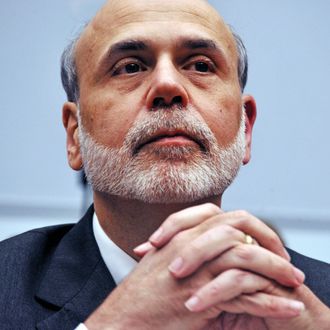
In the past four months, while Washington has flailed to fix the ballooning deficit, Wall Street’s unholy triumvirate of credit ratings agencies have frowned. Amid August’s debt ceiling imbroglio, Standard & Poor’s downgraded American debt from a riskless AAA rating to AA+. Moody’s currently has the rating on a negative watch. And today, in the wake of the supercommittee shutdown, Fitch Ratings issued its harshest threat yet: cut a deal by 2013, or face another full-blown downgrade. The agency didn’t mince words. Washington is “postponing the difficult decisions on tax and spending until after forthcoming congressional and presidential elections,” Fitch said in a statement. “Failure to reach agreement in 2013 on a credible deficit reduction plan … would likely result in a downgrade of the U.S. sovereign rating.”
The supercommittee’s inability to reach a bipartisan deficit-reduction deal was supposed to trigger $1.2 trillion in cuts. Republican senators are now backpedaling on the defense cuts; but President Obama has promised to veto any bill that would change the trigger. The political gridlock is prompting Moody’s and Fitch, who chose not to follow S&P’s downgrading lead this summer, to darken their outlook. But why should we worry about another potential downgrade?
The problem is, most large investors use a “two out of three” approach when evaluating which securities to hold or dump. In many contracts, the relevant rating is the one agreed upon by two of the S&P/Fitch/Moody’s trio. So, if either Fitch or Moody’s joins S&P in downgrading U.S. debt, that could trigger raised interest rates or, for some major investors, the mandatory sale of American debt. When most of these financial contracts were written, treasuries were considered essentially foolproof. A two-out-of-three rating downgrade could trigger some unintended and unsavory effects on bond spreads. Right now, as deficits expand, we need as many investors clamoring for our debt as possible — or we risk paying more and more taxes in servicing it.
The good news is, as monetary Armageddon rumbles in Europe, U.S. treasury bonds are still considered a safe haven, pushing their prices up and rates down. But Greek and Italian woes might not give us cause to celebrate for long. Today, news broke that S&P may be considering downgrading French debt, which was thought to be pretty dull. Moody’s might downgrade a whopping fifteen of Europe’s sovereigns, even the strongest ones. And last week, an auction of German bonds, which used to be the safest bet in Europe, found very few customers. Safe havens are dropping like flies. A second or third credit rating downgrade could make U.S. debt the next “used-to-be-riskless” asset in a very risky financial world.





























